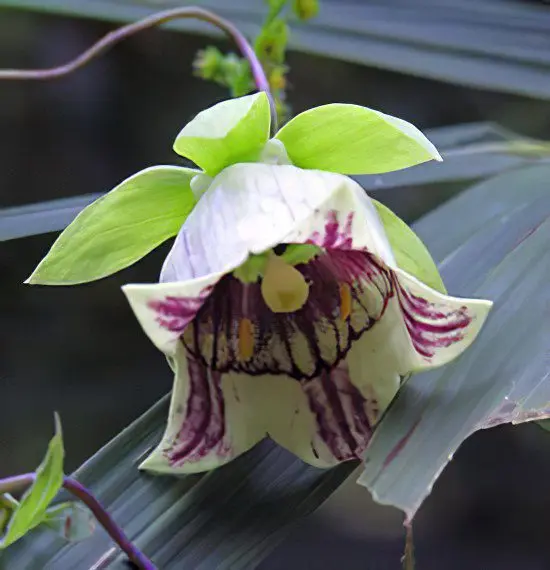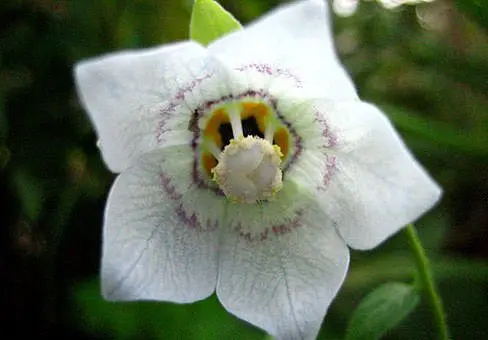Contents
- Useful properties and application of codonopsis
- Botanical characteristics of codonopsis lanceata
- Useful properties of codonopsis
- Application of codonopsis
- A decoction of codonopsis lanceolate
- Infusion of codonopsis lanceolate
- Tincture of codonopsis lanceolate
- Codonopsis clematis
- Codonopsis small-haired
- A decoction of codonopsis small-haired
- Contraindications to the use of codonopsis
Useful properties and application of codonopsis
Botanical characteristics of codonopsis lanceata

Codonopsis lanceolate – perennial climbing plant of the bell family. The stems are bare, occasionally hairy, curly, reaching a length of 200 cm. The root system is powerful, well developed, the main root is radish. The leaves are large, rhombic or broadly lanceolate, short-petiolate (sessile), entire (rarely serrated), glabrous, reaching 4–8 cm in length.
The flowers are apical, solitary, the corolla is bell-shaped, the color is bluish-green or yellow with a purple edge. The fruit is an obversely conical capsule, the seeds are small (2–3 mm), dull, winged. Codonopsis lanceolate blooms from July to August.
The natural distribution area of the medicinal plant is Korea, North China, Japan, and the Far East. It grows in thickets of shrubs (including dense ones), in river valleys and on slopes.
Useful properties of codonopsis
In folk medicine, the underground part of the medicinal plant is used – the radish-like root, as well as the above-ground part – leaves, flowers and seeds. The roots are harvested in the autumn period (the last months of autumn), the seeds – as they ripen, and the flowers and leaves – during the budding period (the beginning of flowering).
In its chemical composition, the roots of a medicinal plant contain a number of useful organic compounds: polysaccharides, sucrose, glucose, steroids, triterpenoids, alkaloids, coumarins, aromatic compounds, organic acids, essential oil, heterocyclic compounds, phospholipids and trace elements.
The chemical composition of the aboveground part of the medicinal plant is similar to the underground part, in addition, in addition, leaves, flowers and seeds contain tannins, pigments and vitamins.
Healing infusions and decoctions of codonopsis have a pronounced expectorant, antitussive, hypotensive effect. Also, with regular use of an infusion from a medicinal plant, leukopoiesis (the process of formation of leukocytes) is inhibited, the body’s resistance to adverse environmental conditions increases significantly, endurance and stress resistance develop.
Application of codonopsis
A decoction from the underground and aboveground parts of codonopsis is used for various respiratory diseases (bronchitis, pneumonia, tracheitis), chronic dystrophy, nephritis, diabetes mellitus, hypertension (high blood pressure), rheumatism and oncological diseases (malignant tumors in the uterus). In addition, the use of medicinal infusions helps in the fight against edema, inflammatory processes in the kidneys, chronic intestinal inflammation and various types of anemia.
A decoction of codonopsis lanceolate
Recipe № 1: 10 g of crushed roots are poured into 200 ml of water, then put in a boiling water bath for 8 minutes, after which they are infused for two hours. The resulting broth is filtered into a clean container and taken 1/3 cup 3 times a day. The decoction is indicated for anemia, diabetes, respiratory diseases and impotence.
Recipe № 2: 15 g of crushed roots are poured into 200 ml of boiling water and put in a boiling water bath for 30 minutes, then cooled for 10 minutes and filtered into a clean container. The resulting volume of the broth is adjusted with purified water to 200 ml and mixed. Take the medicine 2 tablespoons 3 times a day.
Infusion of codonopsis lanceolate
20 g of the aerial part of the medicinal plant is poured into 200 ml of boiling water and infused for 15 minutes, then cooled for 45 minutes and filtered into a clean container. The resulting infusion is taken 1/3 cup 3 times a day.
Tincture of codonopsis lanceolate
1 part of the crushed roots is poured with 5 parts of 70% ethyl alcohol and infused in a dark place for 14 days, after which the product is filtered into a clean container and taken 30-40 drops 3-4 times a day.
Codonopsis clematis

Clematis codonopsis is a perennial climbing plant with creeping shoots, of the bell family. The straight or winding stem reaches a length of 50–70 cm. The leaves are small, ovate or broadly lanceolate, entire. The flowers are apical bells, solitary, large and drooping, bluish-green in color with dark blue veins.
The fruit of the plant is a box, the seeds are smooth, pale brown in color. Clematis-like codonopsis blooms in June-August, bears fruit in August.
The natural distribution area of this species is Central Asia. It grows in damp meadows, as well as along the banks of various reservoirs.
From a medical point of view, codonopsis clematis is of no value, therefore it is used exclusively as an ornamental plant in gardening (usually to decorate artificial reservoirs).
Codonopsis small-haired
Codonopsis small-haired is a perennial climbing plant of the bell family. The stem of the plant is curly, at the base covered with small hairs, in the upper part, as a rule, absolutely smooth. The root is powerful, thick, radish-like, grayish in color, reaches 1,5 cm in diameter. The leaves are petiolate, ovate, entire (leaves are slightly wavy along the edge), opposite or alternate. Flowers solitary, on thin stalks, yellow with a purple tint.
The fruit of the plant is a box, the seeds are small, shiny and smooth. Codonopsis small-haired blooms from August to September.
The natural distribution area is the Far East. This species grows on forest edges and clearings, in thickets of shrubs (including dense ones), as well as along the banks of various reservoirs.
In Chinese and Korean medicine, the underground part of the plant (roots) is used, its above-ground part (grass) is less commonly used.
The roots are harvested in late autumn, and the grass – at the beginning of flowering (during the budding period).
The chemical composition of the roots of codonopsis small hairy contains polysaccharides, glucose, sucrose, mucus, organic compounds, triterpenoids, coumarins, sterols and essential oils.
Flavonoids were found in the chemical composition of the herb of a medicinal plant.
The roots of codonopsis small-haired in Chinese and Korean medicine are considered to be a natural analogue of ginseng in terms of the mechanism of action and the therapeutic effect it has on the human body. A healing decoction of the roots has a tonic and stimulating effect, in addition, it is an effective androgenic and general tonic.
A decoction of codonopsis small-haired
15–20 g of medicinal raw materials (crushed dry roots) are poured into 400 ml of water and put in a boiling water bath for 7–8 minutes, then infused for two hours and filtered into a clean container. Take the remedy for 0,5 cup 3-4 times a day before meals.
Contraindications to the use of codonopsis
The use of a decoction of the roots of codonopsis is unacceptable during pregnancy and lactation (breastfeeding). Also, with extreme caution, a healing decoction should be taken by people with cardiovascular diseases (tachycardia) and individual intolerance (allergic reactions).









